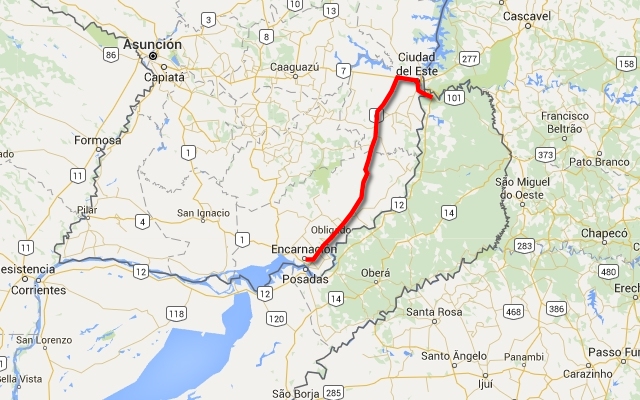
Nothing compares to the simple pleasure of a bike ride. J.F.Kennedy
Search this website
To Encarnatión
Puerto Iguazú, Presidente Franco, Ciudad del Este, Santa Rita, Naranjal, Maria Auxiliadora, Bella Vista, Trinidad, Encarnatión
Back to Paraguay
I do not like returning on the same route. For the way back, I chose the ferry over the Paraná River to Presidente Franco. I found the harbor in Puerto Iguazú quite easily in my GPS and once again, I was lucky, as the ferry was sailing in 10 minutes. I paid 25 Pesos (about CZK 65, $3.25) for the roughly 20-minute crossing of the Iguazú and Paraná Rivers. I also skipped the two additional Brazilian passport stamps.
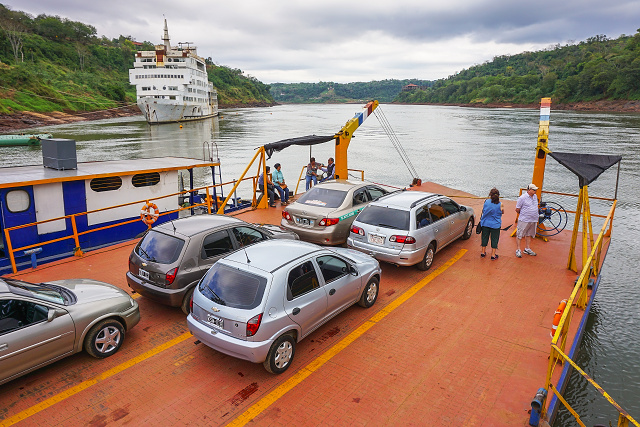
Puerto Iguazú: Ferry from Argentina to Paraguay

Puerto Iguazú: Confluence of Iguazú and Paraná Rivers, the building is on the Brazilian side
Thanks to the ferry voyage, I got close to Saltos del Monday waterfalls, so I visited them. The weather deteriorated, with intermittent rain. I even had to seek shelter for 20 minutes to prevent the unnecessary soaking of my clothes. When it rains in Paraguay, the road, the bicycle and panniers all turn red. The waterfalls, although quite nice, could not compare to the majestic Iguazú Waterfalls. It did not improve matters when the lower viewing platform was inaccessible – the elevator was turned off and the gate to the stairs locked. I first thought it was due to the high water levels, but on my way out, I noticed a repairman fixing the switchboard. Seemed like ongoing total reconstruction.
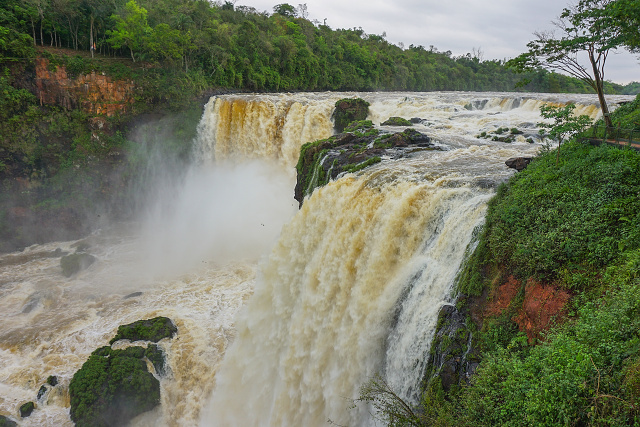
Prezidente Franco: Saltos del Monday waterfalls
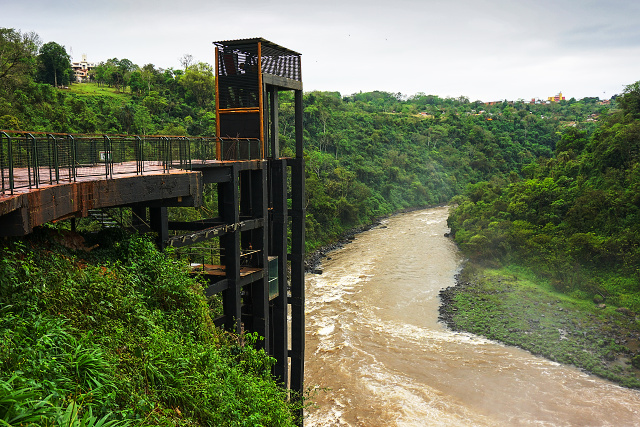
Prezidente Franco: Saltos del Monday waterfalls - elevator to the surface of the river below the waterfall was closed
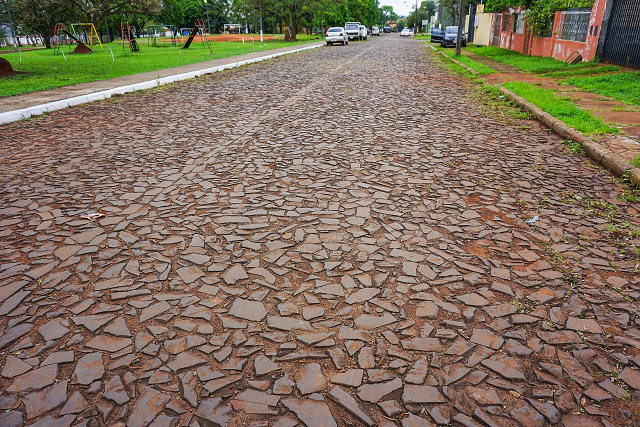
Prezidente Franco: Paving of side streets is not very conducive to cycling
I returned to Ciudad del Este, because I would have to use Road 7 on my way to Encarnación. It was possible to use smaller dusty roads, but after such heavy rain which fell that evening, I would be totally covered in red mud from head to toe. I would get enough of it anyway on the verge of the asphalted road, which was suffused in red mud from the roadside. To save on weight, I did not have mudguards installed on my bicycle. The upper pannier at the back received the most dirt, but in the front it hit my legs and often even my face.
I found accommodation in the same place as before, the Hummingbird Hostel. It was fully booked and I was to share my room with an Austrian man. This option was also cheaper. In the evening, the Austrian called the hostel and informed them that, due to the rain, he would not be arriving. Fine. Two blocks away was a large supermarket with a food hall selling food by weight. This is quite common there. One chooses what one likes and pays between CZK 100-150 ($5-7.50) per kilogram. This seemed good, one could choose only meat, if one so wished. I picked a chomp of beef and a piece of pork, together about 400 g, with manioc, salad, sopa paraguaya (not a soup, but rather something like Easter stuffing), some noodles and a big pudding. All together 750g, I ate so much that I had to skip dinner.
Then I went for a walk into the city and took some genre photos.
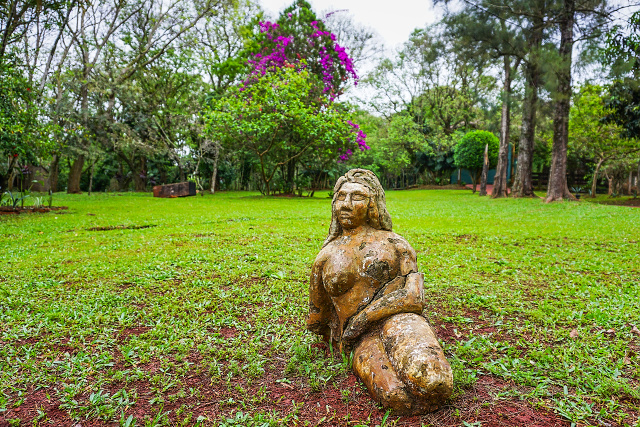
Prezidente Franco: Sculpture in the park
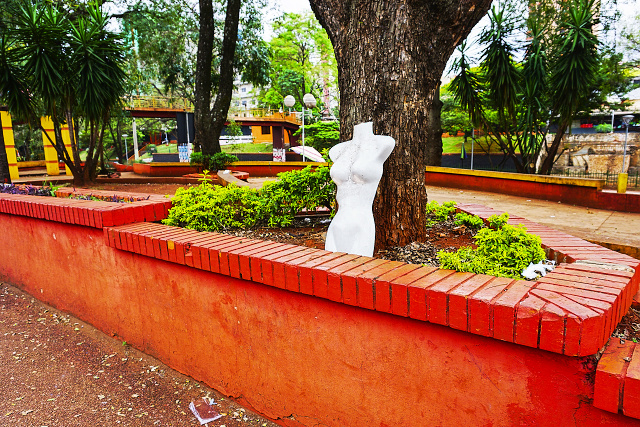
Ciudad del Este: Discarded torso
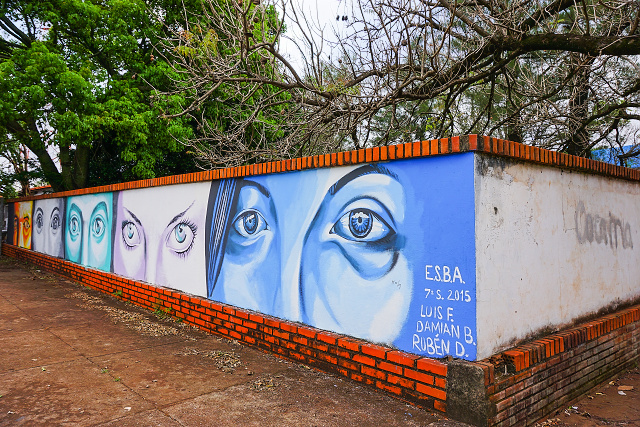
Ciudad del Este: Mural
In the evening, it started raining and it rained the whole night. The weather still seemed terrible in the morning, so I considered whether to continue. I put on my rainproof jacket and pants and stepped on it. The rain was not that bad after all, and it gradually weakened and stopped totally after two hours. This, however, did not improve the verge, covered in dense red mud, of which a thin layer covered my whole bicycle, panniers and most of what I was wearing. Only my face remained intact.
The wind was more disturbing. For the first 27 km, I returned on Road 7 towards Asunción and it blew from the 9 o´clock direction. Then I turned left on to Road 6 and it blew straight into my face. I comforted myself with the fact that it was not raining. It was better cycling against the wind than in the rain. Or even worse, rain and a headwind at the same time. The side lane was gradually drying out, which created another problem – the headwind blew fine dust into my face. I had to protect my eyes, so every time a truck passed me, I shut them and cycled from memory.
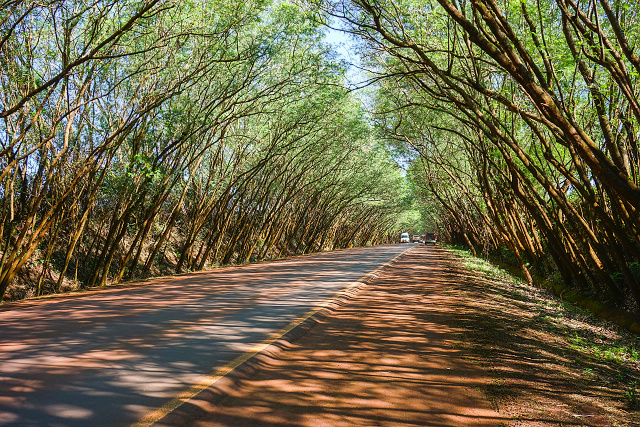
S of Santa Rita: Trees finally sheltering me from strong headwind
The last accomodation on Road 6 was in Santa Rita. I had cycled almost 90 km and wanted to continue, so at a crossroads I inquired about my options. I was sent to the 7-km distant Naranjal, to which a typical, stone tiled road led. The end of that day was highly demanding. There were two hotels in Naranjal across the street from each other. Both equally shabby (which seemed to be the norm) and both without WiFi. I picked the first one, bargained down the price a bit, purchased my breakfast in a local supermarket and had dinner in the only open restaurant.
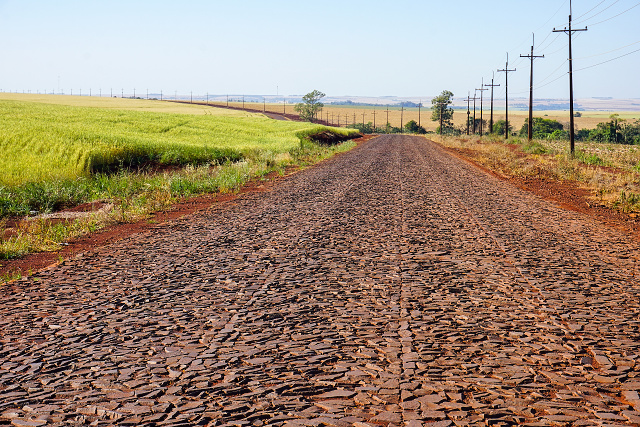
Naranjal: Rude morning awakening on 7-km rough road
The morning exercise was replaced by cycling on the rough tiles which made me greatly appreciate an asphalt road again. The countryside was agricultural, the more South, the more cultivated it was, originally by German, Ukrainian and Russian settlers. Beside the road were only adverts for industrial fertilizers and pesticides. Considering the wooden houses, it did not seem that the locals were well off. With respect for poor people, I did not photograph the extensive slums of plywood, corrugated iron sheets and plastic, which lined the road in one place for a whole 3 km. What was interesting was that most of the slums also had satellite dishes and sometimes a primitive volleyball field. The local residents waved at me with interest and cheered me on, especially when it was uphill.
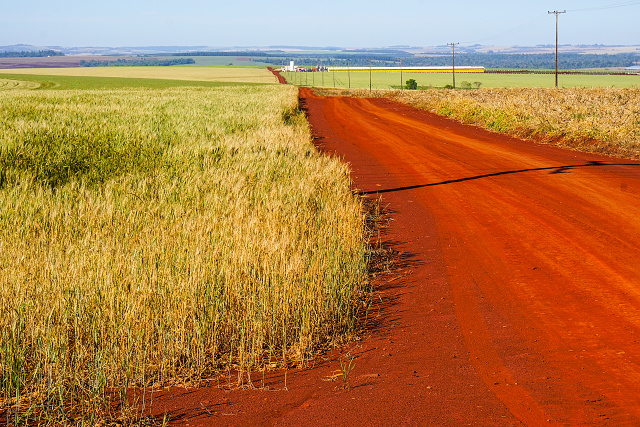
Naranjal: Agricultural landscape, typical red soil

Iruna: House of a well-off family
I was most confused by the road map which I had purchased for about CZK 70 ($3.50), as it used the town names from the time when they were named after dictator Stroessner's friends. Although I cycled to Tomás. R. Pereira, I arrived in Maria Auxiliadora. There were also some other inaccuracies. The road plan I had received free of charge at Asunción Airport was of a better quality.
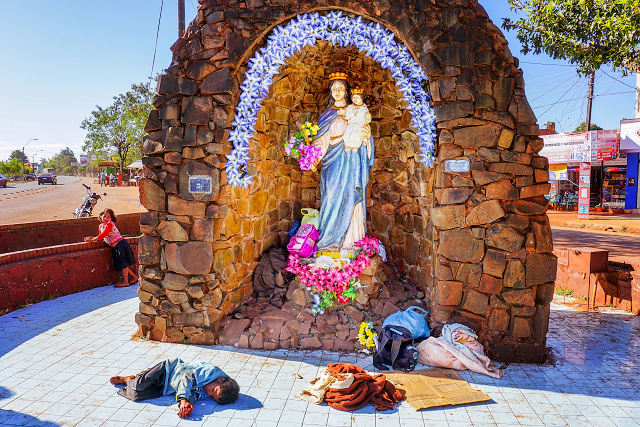
Maria Auxiliadora: Famous statue of the Virgin Mary
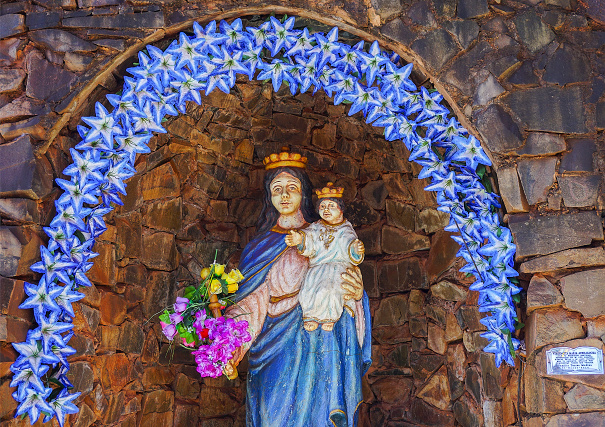
Maria Auxiliadora: Detail of the statue
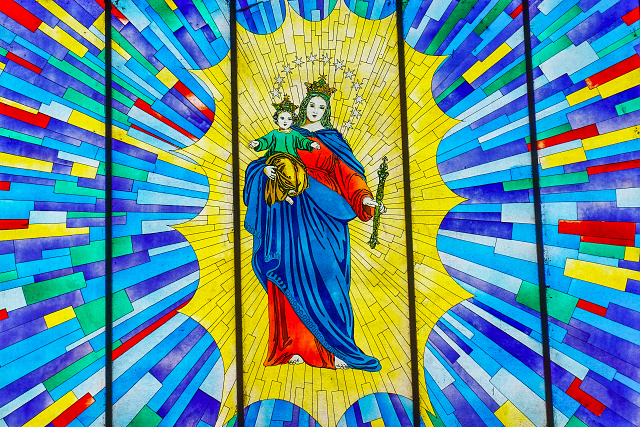
Maria Auxiliadora: Large stained glass window above the church entrance
Regardless of the religious name of the city, the owner of a small supermarket tried to cheat me. I purchased 1 liter of beer, usually costing, together with the bottle, 10 000 Gs (under CZK 50, $2.50). But the lady tried to get 20 000 Gs from me, claiming that the bottle deposit was 10 000 Gs. Clearly nonsense. I paid the amount and asked what time she would be closing the store. Two hours later, I went to return the bottle, already calling at the door "Bottle for 10 000" and she almost ran to return the money to me, so that I would not cause a scandal.
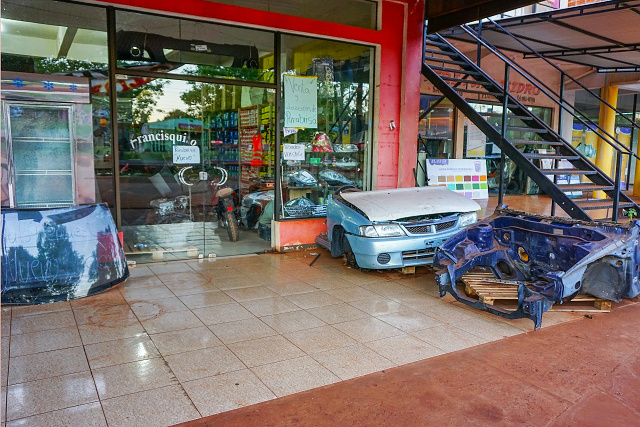
Maria Auxiliadora: Spare parts store
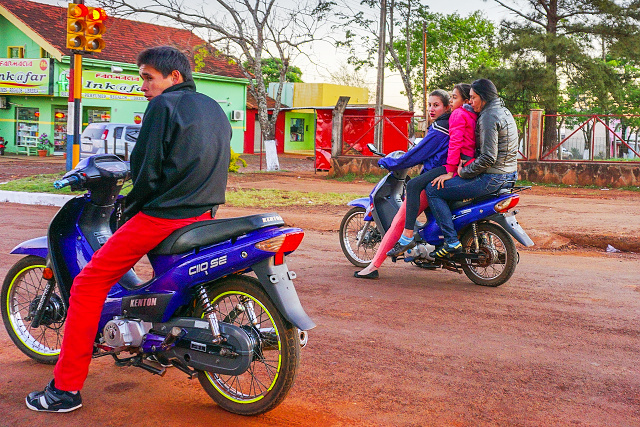
Maria Auxiliadora: Motorcycle is a means of public transport here
In the usual scruffy hotel, I could use the washer for 12 kg of clothes. I had some problems with it, but in the end it started to work. One hour later, I hung the clothes in the garden and my laundry was sorted out for another eight days. WiFi was not available, I hoped to be able to connect in Encarnación.
As I continued southwards, it was obvious that the European settlers were doing well. Along the road were modern agricultural "industries," brick houses with maintained surroundings, signs in the fields for the various product and fertilizer names which were being used there. The German towns of Bella Vista, Obligado and Hohenau, who had closely collaborated under Colonias Unidas, seemed to be doing the best. There were also real European-style hotels in these cities, with waiters in black clothes, and mind you, even ties! The latter I had not seen worn there by anyone for a long time.
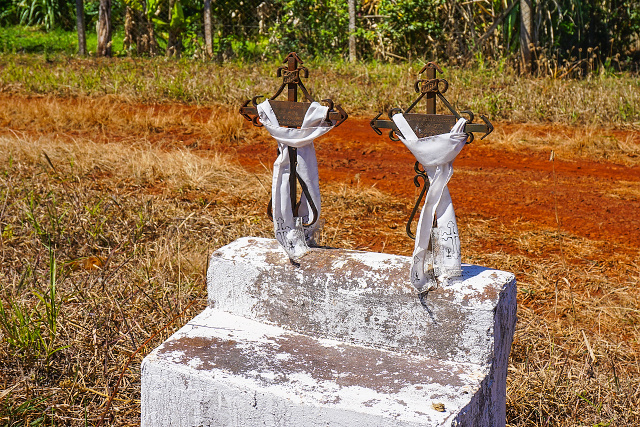
N of Bella Vista: Typical decoration of crosses beside the road
I was in a good mood. I ate lunch in a comida-per-kilo type of canteen (buffet, with food paid for by weight). First of all, I wanted to stay in Bella Vista and, on the following morning, go on an excursion to a factory producing Mate. Mate, together with tereré, is the national drink. People often carry big thermos flasks filled with hot water and a container of Mate with a typical metal "straw,” called a bombilla in Spanish. I had cycled only a little over 70 km and still felt strong and eager to continue. In a better looking hotel, I asked whether Trinidad offered any accommodation. When they confirmed this, I continued cycling.
On the Sunday afternoon, all the stores were closed. I became concerned about where I could purchase the beer which I really needed in that heat (max. 39 degrees). Luckily, gas stations were open, and they had stocks. At the entrance to Trinidad, I spotted a sign for a campsite with a restaurant, swimming pool, sports hall, art shows – in other words, it was too good to be true. It was only 500 meters away, so I went to check it out. After 500 meters, there was a new sign of 1200 meters. Then another one and I started to see right through it. It was a total of 4 km, the last part on a forest road covered in a layer of sand. There was nothing there that had been promised. It was an unsuccessful project, whose owners had not even had the energy to remove the signs. Only a dirty, hairy owner, who was chopping up meat for dogs and shouting at them not to jump on me, was on the spot.
I returned to Trinidad and found accommodation in A las Ruinas, a Paraguayan brothel-style hotel. The advantage was its location at the gates of the famous Jesuit colony ruins.
Santísima Trinidad del Paraná
Experiencing literally physical pleasure, I devoured one liter of Brahma beer, did not even change my clothes and went directly to admire the remains of the Jesuit colony. I was ecstatic. The ruins are quite widespread, include two churches, stone houses for 4000 Native Paraguayans, and a tower. The preserved statue of a saint is a curiosity. Most of the statues of that time were destroyed, because thieves believed that the inside of statues were golden.
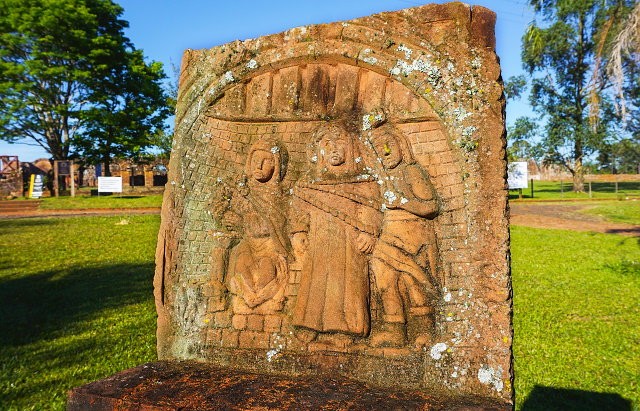
Santísima Trinidad del Paraná: Jesuit mission - Calvary
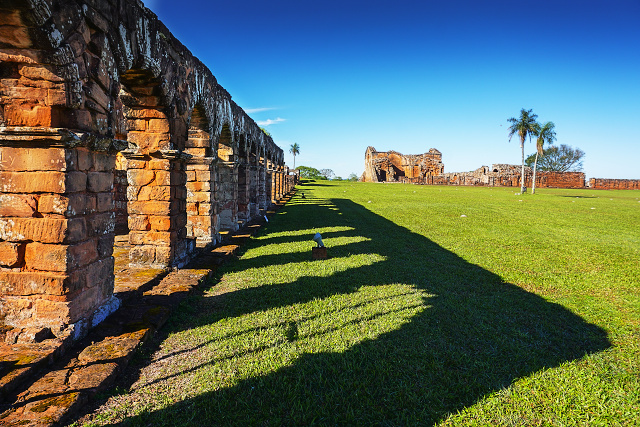
Santísima Trinidad del Paraná: Jesuit mission - large spaces, the main church in the background
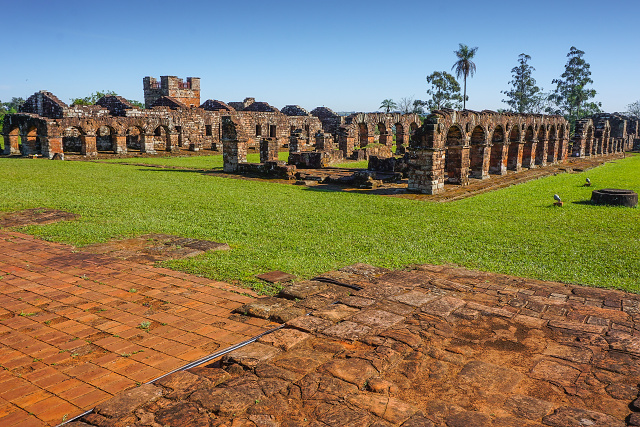
Santísima Trinidad del Paraná: Jesuit mission – Indian dwelling
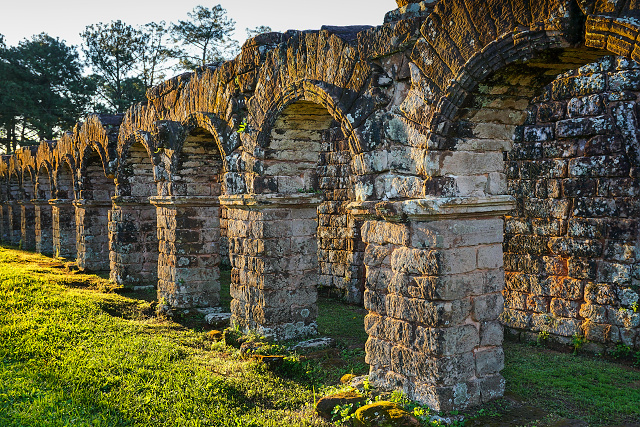
Santísima Trinidad del Paraná: Jesuit mission – Indian dwelling
There are more remains of Jesuit missions in Paraguay and Argentina. The one in Trinidad belongs among the most preserved ones, as recognized by UNESCO. It is an interesting phenomenon. Not much is known about it; it is not known whether Native Paraguayans were used as slaves or if they had equal rights in society. And Jesuits were very scarce; in Trinidad there were only 2-3 Jesuit priests to 4?000 Native Paraguayans.
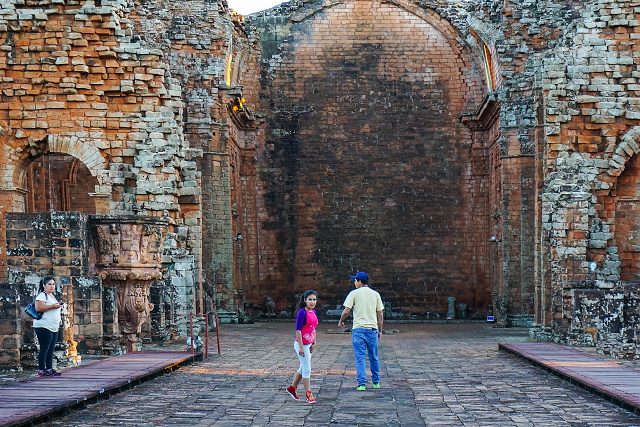
Santísima Trinidad del Paraná: Jesuit mission - in the main church
The whole project was extremely successful, which is also what led to its failure, as the Spanish King was worried that the Jesuits would take over the region, so he forcefully returned them to Spain.
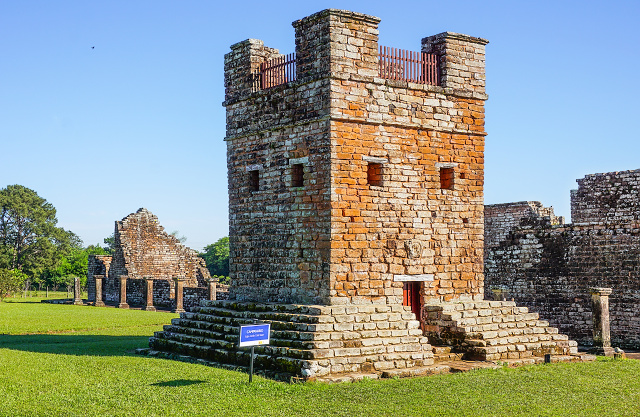
Santísima Trinidad del Paraná: Jesuit mission - tower
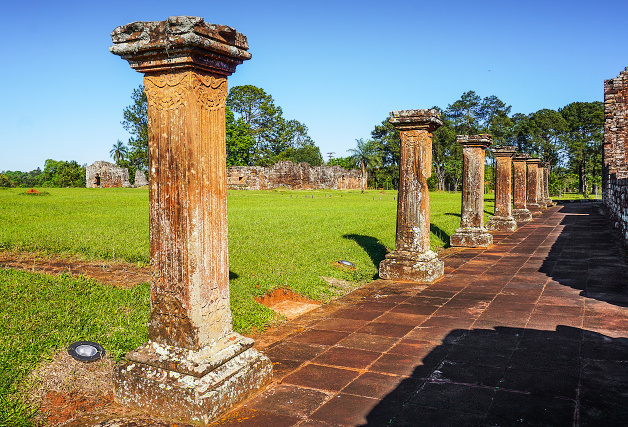
Santísima Trinidad del Paraná: Jesuit mission - portico of smaller church
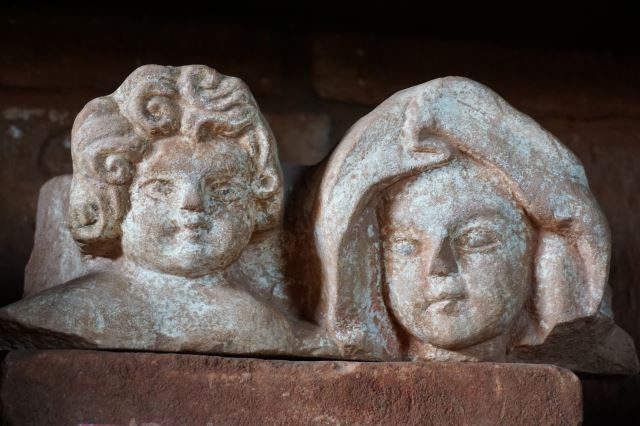
Santísima Trinidad del Paraná: Jesuit mission - head of the Virgin and Child in the museum
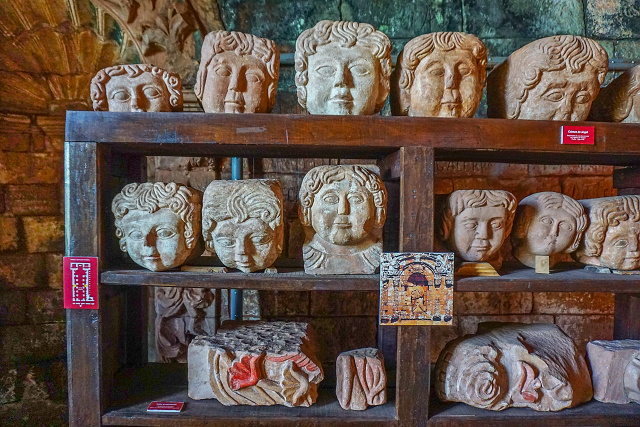
Santísima Trinidad del Paraná: Jesuit mission - heads of angels in the museum
After that evening excursion, I ate dinner in the hotel and immediately had some company. On the left sat a cat and on the right a dog. Both checking me out. While the dog was shaking with excitement, wondering if he would get some food, the cat was more agile. At regular intervals, she reminded me of her presence by meowing while she stretched and scratched at my waist with her paw. I could not resist them, so both received a bit of meat.
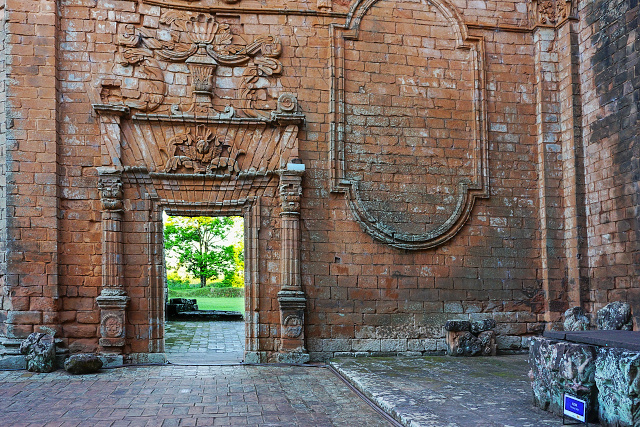
Santísima Trinidad del Paraná: Jesuit mission - main church
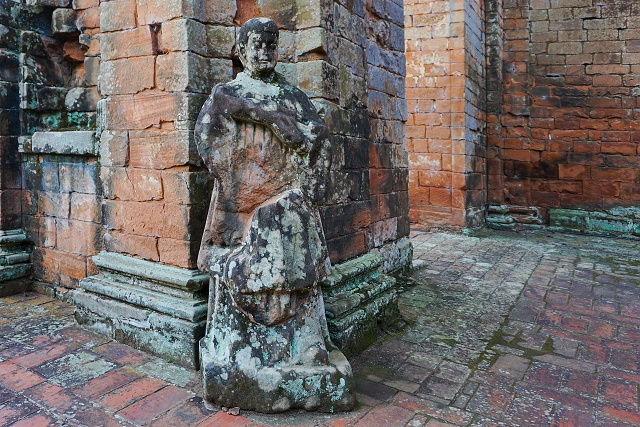
Santísima Trinidad del Paraná: Jesuit mission – the only preserved statue
The advantage of staying so close to the ruins was the opportunity to visit the evening Light and Music Show. It was amazing. Baroque music filled with Native Paraguayan guarani screams and rainforest sounds, strange lighting of the whole area with the stars shining brightly above in the pitch black sky. The experience was only disturbed by the very talkative guide of a small group, who was constantly pushing some data and facts into their heads. I had to distance myself from them.
I returned to the ruins once again the following morning before breakfast, still on the ticket purchased the previous day (2500 Gs, CZK 120, $6). This is why there is different light in my photos.
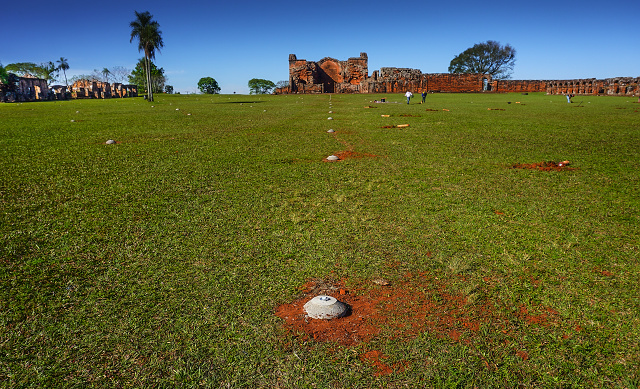
Santísima Trinidad del Paraná: Jesuit mission - light in lawn used for night performances
To conclude the Paraguayan mission, I only had to reach Encarnatión, a city 35 km away. With an unusual wind at my back, I enjoyed the ride.
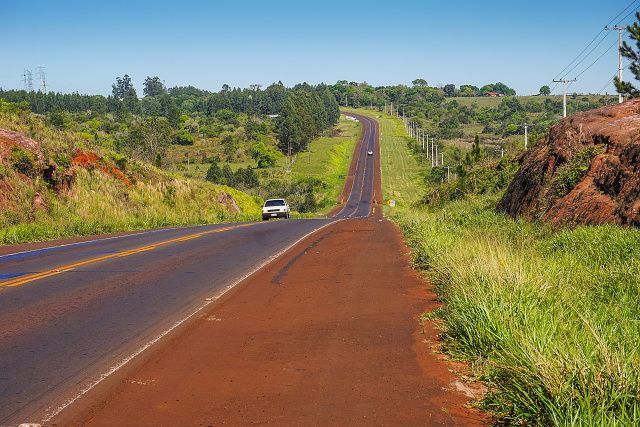
Trinidad: Typical profile of a Paraguayan road - no flat land
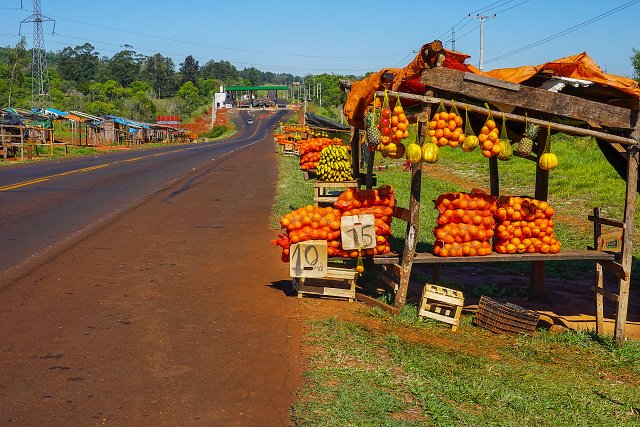
Trinidad: Roadside fruit stall, tollgate in the background
Encarnatión
The second Paraguayan city (after Asunción) which really looks like a city. It has a square, churches and original houses. There are not many, though, as the settlements in the lower heights were flooded by the Paraná River after a dam was built there.
The city is famous for its carnivals. These take place on the Paraná River embankment, where a sambodromo is constructed for the dancing team performances competing for audiences. The area along the river has been newly reconstructed, with a sandy beach and a view of the better prospering Argentinian city of Posadas.
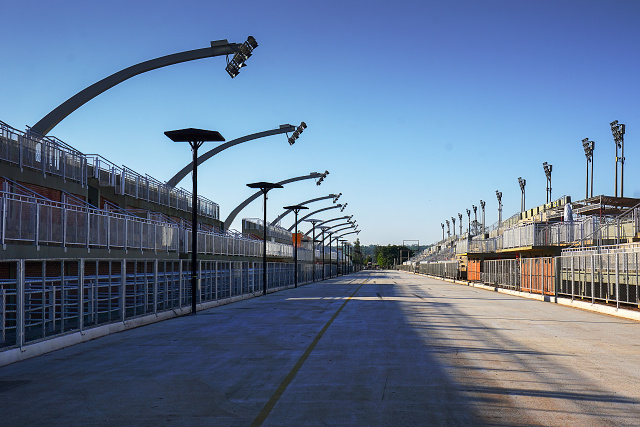
Encarnatión: Sambodromo - dance groups showing off during the annual carnival
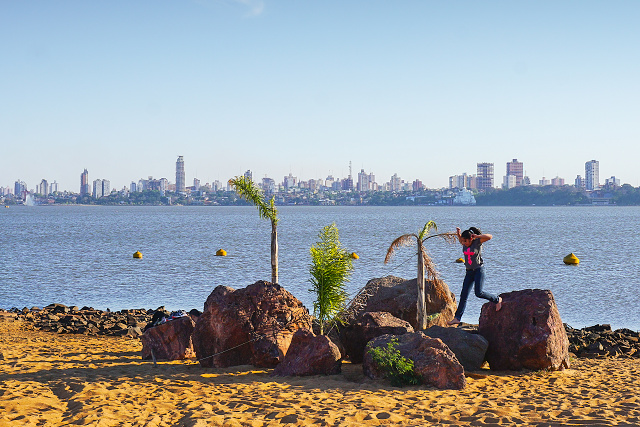
Encarnatión: City beach, Argentine city of Posadas in background over Paraná River
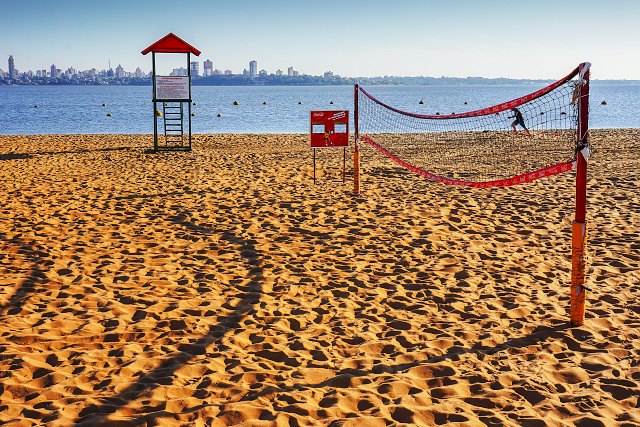
Encarnatión: City beach
I found the main square amusing, with the typical name of Plaza de Armas. A mishmash of everything from a Japanese garden to a bust of the poet Shevchenko, in the part dedicated to Ukrainian settlers. The city also has Russian Orthodox churches, but I visited the Cathedral instead.
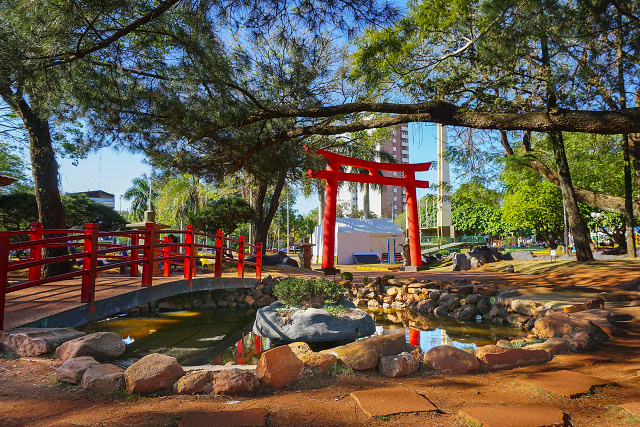
Encarnatión: Japanese garden at Plaza de Armas
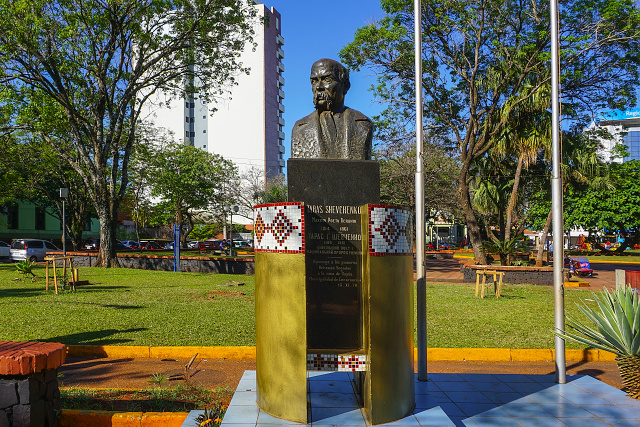
Encarnatión: Bust of Ukrainian poet Shevchenko on Plaza de Armas
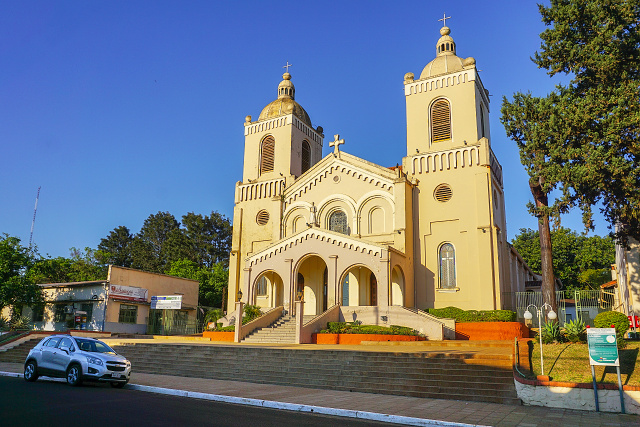
Encarnatión: Cathedral

Encarnatión: Marian statue in Cathedral
